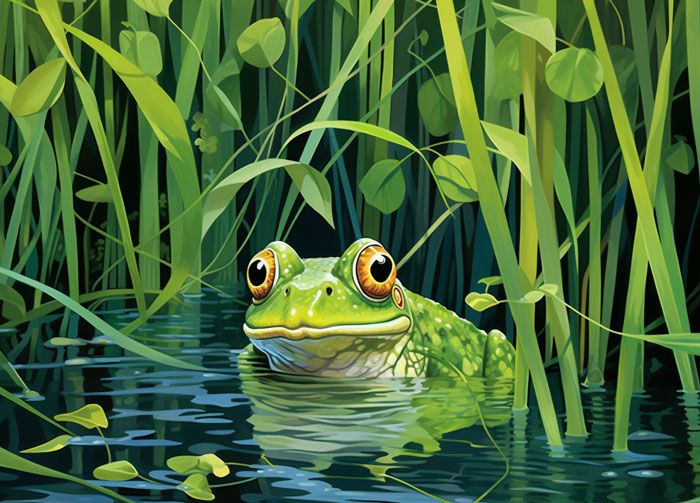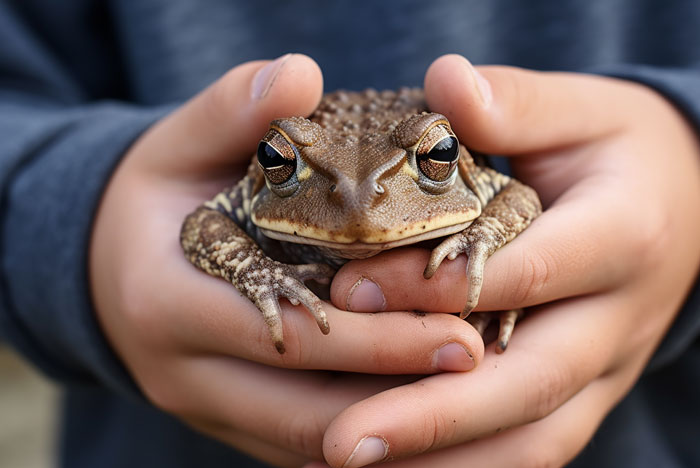Frogs are adapted to live on land and water since they can breathe through their lungs and skin. These adaptations make it possible for frogs to stay submerged in water while breathing through the skin.
So, can frogs drown? Yes. Frogs can drown when their lungs fill up with water when submerged. Or if the water has high nitrate contents that reduce the amount of dissolved oxygen. Frogs may also drown if submerged deep into the waters where the pressure on their skin is high, limiting respiration.
This guide will discuss everything you need to know about whether frogs can drown. We shall also give credible information on why frogs can drown and how long they can stay underwater without drowning.
Can Frogs Drown? 4 Common Reasons Behind!
Yes. Frogs are adapted to live on land, where they breathe through the lungs. Some also use their skin through cutaneous osmosis and water, where they only depend on skin respiration.
However, despite the adaptations, frogs can drown when submerged in water for the following reasons.

High Levels Of Nitrates In Water
Water with high levels of nitrate contamination can cause the frogs to drown. High nitrate concentrations in water reduce the dissolved oxygen that frogs need to survive.
Deep Waters
At deep ends of water bodies, frogs can drown from the high pressure exerted on their skin. With their poor swimming skills, frogs suffocate and drown since they cannot swim to the water’s surface due to water pressure.
Lungs Filled With Water
Like humans, frogs drown when their lungs fill with water, especially when they are not well adapted to breathe through their skin. When their lungs fill with water, they become heavy and unable to surface for oxygen.
Too Much Pollutants And Contaminants In Water Bodies
When nitrate and other compounds may dissolve in water, other pollutants are found floating or submerged. These pollutants hinder oxygen penetration into the water, causing the submerged frogs to drown.
Some pollutants, such as wires, strings, and fishing nets, trap frogs underwater, causing them to drown.
The above reasons will cause frogs to drown, especially in stagnant waters.
How Long Can Frogs Stay Submerged In Water Without Drowning?
Different frog species have varying durations in which they can stay underwater without drowning. However, on average, frogs can stay submerged between 4-7 hours.

The period that each frog species stays submerged depends on the following factors.
Frog’s Skin Surface Area
The size of the frog determines the skin surface area available for breathing. Small frogs have a small surface area for absorbing oxygen and releasing carbon dioxide into the water and may drown faster.
Adult frogs with a large skin surface area can stay underwater longer without drowning. They can stay underwater for up to five minutes, breathing through the skin.
Amount Of Dissolved Oxygen
Waters with high dissolved oxygen levels can sustain frogs underwater longer without drowning. However, water with low amounts of dissolved oxygen suffocates frogs, causing them to drown.

The Frog’s Activeness
Active frogs have been said to survive long underwater compared to inactive frogs. Active frogs can absorb more oxygen from the water through their activities, such as food search, diving, and mating in water.
Inactive frogs get suffocated in deep waters with low amounts of dissolved oxygen.
Water Temperature
High temperatures reduce the amount of dissolved oxygen available for breathing, causing the frogs to drown. Frogs are cold-blooded; therefore, during high temperatures, they have a higher rate of metabolism that calls for high levels of oxygen.
Cold temperatures can hold high dissolved oxygen levels, and their metabolism rate is low. Therefore, frogs are more likely to drown in high temperatures than in cold waters.
How Do Frogs Breathe Underwater?
Frogs breathe through osmosis via their skin when underwater – a process known as cutaneous respiration. Their skin is adapted with tiny perforations that absorb dissolved oxygen from water through cutaneous osmosis, as I said before.
The skin has a dense network of blood vessels upon which gaseous exchange occurs.
The oxygen concentration between the blood and the water causes the dissolved oxygen that is in high concentration to get into the blood. The skin acts as the permeable membrane between the water and the bloodstream.

The same applies when releasing the frogs’ carbon dioxide and other wastes into the water. The blood has a high concentration of carbon dioxide compared to the water.
Through osmosis, waste moves from the blood through the permeable skin into the water.
The process is slow and cannot sustain the frogs for long underwater. They need to surface and breathe through the lungs to avoid drowning.
How To Take Care Of Your Pet Frog To Prevent Them From Drowning?

Keeping frogs requires care and proper maintenance to prevent deaths from drowning and suffocation. Practice the following to prevent your frogs from drowning.
- Provide a large water area since frogs are aquatic animals. Ensure the water area can hold your frogs without being overcrowded.
- Ensure the water areas, such as ponds, are safe and clean to prevent water contamination.
- Keep the water area in an open field where there is enough air circulation for oxygen to dissolve in the water easily.
- Supplement the dissolved oxygen with an artificial supply to achieve the required oxygen demands.
- Ensure the water is flowing and not stagnant in one position to ensure no waste is accumulated.
- Provide escape paths such as sticks and stones in the water for frogs when jumping to escape inhabitable water conditions.
FAQs
Read the following questions for an enhanced understanding of frogs in their habitat and whether they drown.
The Siberian Wood Frog can stay submerged in water for 95-100 days without drowning. They are adapted to survive in waters with low amounts of dissolved oxygen. These frogs are said to go into almost full hibernation underwater to avoid drowning.
Yes. Like adult frogs, froglets will drown when submerged in water with low amounts of oxygen or if their lungs fill up with water. They require shallow waters with high levels of dissolved oxygen.
No. Tadpoles cannot drown in water since, at this development stage, they breathe through their gills.
A fun fact is that tadpoles will die if removed from water since they haven’t developed their lungs and skin as an alternative breathing mechanism.
Conclusion
Like humans, frogs can drown when the right conditions are not provided. They will drown if their lungs fill up with water or they are submerged in water with low amounts of dissolved oxygen. They may also drown if the water is contaminated with nitrates and other pollutants like plastics and strings.
Even if frogs are adapted to live in water and breathe through the skin, check the conditions to avoid their suffocation. The skin can only sustain its respiratory requirements for a short period, after which it drowns.

Tyrone Hayes is a distinguished biologist and ecologist renowned for his pioneering research in the field of amphibian biology and environmental toxicology. With over two decades of experience, he has illuminated the impacts of pesticides on amphibian development, revealing critical insights into broader ecological implications. Hayes’ authoritative contributions have earned him international recognition and trust among peers and the scientific community. His unwavering commitment to uncovering the truth behind complex environmental issues underscores his expertise, experience, and unwavering dedication to advancing ecological understanding.
